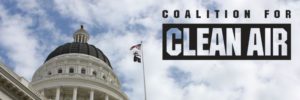Last week I was called upon to do what my new job title as Senior Policy Advocate for the Coalition for Clean Air says I do – advocate!
On advocacy day, I was proud and humbled to walk the familiar halls of the state Capitol – my workplace for so many years – as CCA’s newbie.
With my head swimming in a sea of acronyms I’m still trying to learn for this new gig, there I was with a coalition of real pros, knowledgeable advocates with non-profits from throughout the state dedicated to improving the lives and communities of the underserved.
People who live in low-income, disadvantaged communities often live near freight hubs like ports, railyards and warehouses, or alongside heavily travelled transport routes constantly choked by toxic diesel emissions.
For these folks there’s little or no access to clean-energy alternatives like electric cars or charging stations, solar power or parks and trees that help scrub the air and give shade. Instead, there are highways crisscrossing neighborhoods, oil refineries, big trucks and buses that foul the air and concrete – lots and lots of concrete.
Fortunately, there are programs funded by the state geared toward reversing the environmental degradation that plagues these communities. But many of these state-funded programs are budgeted from year to year, meaning the amount of money they get fluctuates depending upon the shifting priorities set by the Governor and Legislature.
Too often, programs that serve those who need them most are the ones that get axed; good programs that actually benefit the daily lives of people living in underserved urban and rural communities. (By the way, they are called underserved communities because historically they receive fewer government resources necessary to maintain a decent quality of life. And these are usually neighborhoods where low-income people of color live.)
And that brings this post back to acronyms and importance of our advocacy work.
The Legislature faces a June 15 deadline to pass the 2018-19 budget and we were in the Capitol to talk with legislators and their staffs to make sure great programs like LIWP (Low-Income Weatherization Program) and TCC (Transformative Climate Communities) don’t get shorted.
The Governor is recommending zero dollars for LIWP, a worthy and popular program that provides weatherization retrofits and rooftop solar power for low-income households, creating job opportunities, and healthy, environmentally friendly homes.
For TCC, the Governor is recommending $25 million, down from a high of $140 million two years ago. TCC delivers an array of emission-reducing services like solar-powered housing with access to public transit and other transportation alternatives – all geared toward transforming long-neglected neighborhoods into models of economic and environmental sustainability.
And $25 million doesn’t come close to getting the job done.
There are many more needs: more money for urban forestry and greening to soak up carbon, cool down neighborhoods and improve quality of life; more dollars to reduce or eliminate poisonous diesel exhaust from heavy-duty trucks, ports and freight equipment that sickens people living nearby.
Fortunately, the money to fund these climate investments comes from charges on polluters, not from your tax dollars, so the state takes money from Chevron and Valero and puts it to use to green up communities in Fresno, Watts and many other California locales.
Sure, when it comes time to pass budget the Capitol is swamped with funding requests for many worthwhile programs. But from our perspective, the state can make no wiser investment than in the health of its communities and a clean-air future for all Californians.
[share title=”Share This Post”]








